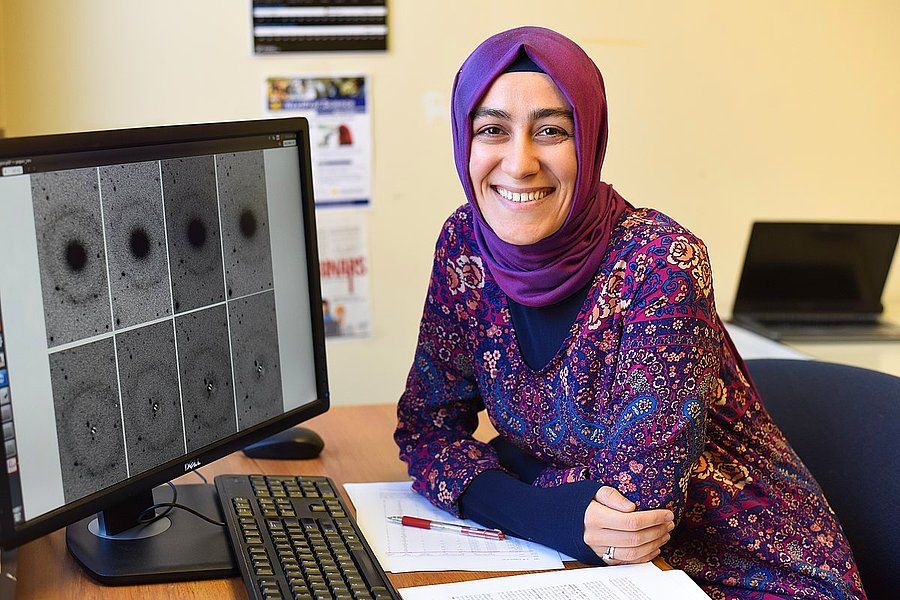
The Muslimah Scientist Who Discovered A Whole New Type Of Galaxy
Turkish-born astrophysicist Burçin Mutlu-Pakdil shares her name with a rare double ring of stars more than 350 million light-years away.
Burçin Mutlu-Pakdil is an astrophysicist at the University of Arizona. She is a 2018 TED Fellow.
Mutlu-Pakdil grew up in Turkey, where she loved physics and the night sky. She attended Beşiktaş Atatürk Anatolian High School and was the first generation of her family to attend college. She completed her undergraduate studies at Bilkent University in 2009.
“Even though my family supported my decision and encouraged me to follow my passion, friends and relatives said that girls should not leave home to study,” Mutlu-Pakdil says. A professor at the college also questioned her decision to move cities to study science. Perhaps not surprisingly, she was one of the few female students in her class.
She moved to Texas Tech University for her graduate studies, gaining a master’s degree in 2012. In 2017 she earned her PhD, “Testing supermassive black hole scaling relations using cosmological simulations and optical/near-IR imaging data” from University of Minnesota, Twin Cities.
In 2017 she was appointed a postdoctoral research associate at University of Arizona. She works at the Steward Observatory looking at the structure and dynamics of astrophysical objects, including dwarf galaxies, galactic rings and supermassive black holes. She uses telescopes in Chile and Hawaii. Here she co-chairs the Women in Astronomy group. She is an American Astronomical Society ambassador.
During her doctoral studies, Mutlu-Pakdil discovered the galaxy PGC 1000714, which has been nicknamed “Burçin’s galaxy”. PGC 1000714 is an extremely rare double ringed elliptical galaxy, and her discovery generated extensive media coverage.
When Mutlu-Pakdil and her team first took note of a little galaxy named PGC 1000714, they mistook it as a Hoag-type galaxy, and they were pretty excited by their discovery. But when Mutlu-Pakdil studied the galaxy further, she was astounded to find that the unusual galaxy had more secrets to reveal.
“In between the blue outer ring and the red central core, we found a diffused red-colored inner ring surrounding the central body,” she says. “We were looking at a galaxy that had never been seen before.”
The celestial body came to be known as Burçin’s galaxy, and it is now providing astronomers with an intriguing mystery: How did such a strange object form in the first place? As with Hoag-type galaxies, the red central core is older than the blue outer ring. But in Burçin’s galaxy, the extra inner ring is the oldest of the lot, indicating that it formed first.
While Mutlu-Pakdil and her team continue to study the intriguing object, she hopes that her work and her story will inspire other immigrants and students, especially those from underrepresented communities.
“When I am invited to schools or when people reach out to me through the social media, I always make it a point to emphasise that you should not block your scientific curiosity because of external pressures,” she says. “The journey may not be an easy one, but you should follow your passion.”
A publisher has approached Mutlu-Pakdil to write a book about her experiences as an astrophysicist, and in 2018 she was selected as a TED fellow, one of just 20 invited change makers from around the world.
“The platform gave me a voice and a presence I had never imagined for myself.” While preparing her TED talk, she presented it first to friends, who said it was hard to understand. “It took several drafts; I worked by trial and error till I had a draft that conveyed the information I wanted to share without being too technical,” she says.
“That’s the rule of life too, isn’t it,” she adds. “You might not get the result you want on the first try. Every time you fail, you get up and try again, and then eventually, you get there.”
Source: National Geographic

